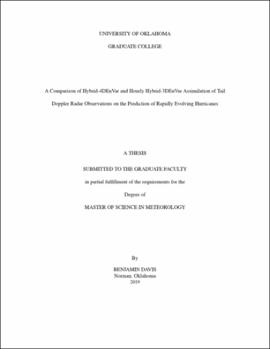| dc.description.abstract | Beginning in the summer of 2017 the National Weather Service upgraded the operational Hurricane WRF (HWRF) to a continuously cycled Gridpoint Statistical Interpolation (GSI) based, 6-hourly, Hybrid 3-dimensional (3D) Ensemble-Variational (EnVar) data assimilation (DA) system. The Hybrid-3DEnVar system assumes the background error covariance is constant throughout the 6 hour DA window and is therefore unable to account for temporal evolution. During rapidly evolving conditions this assumption can cause analyses to be sub-optimal which can lead to degraded forecast performance. Furthermore, in a cycled DA system this problem may be more pronounced due to the accumulation of these errors over successive cycles. The first goal of this thesis is to evaluate methods to improve analysis and forecast accuracy compared to the 6-hourly Hybrid-3DEnVar system by accounting for the evolution of background error covariance.
Two methods are considered that are expected to produce improved analyses and forecasts compared to the 6-Hourly Hybrid 3DEnVar in HWRF by accounting for evolution of the background error covariance: 1) 4DEnVar with 6-hourly frequency (hereafter 4DEnVar), and 2) 3DEnVar with hourly frequency (hourly-3DEnVar). In 4DEnVar, the temporal evolution of error covariances is incorporated through the use of 4-dimensional ensemble perturbations with implicit linearity assumption during the minimizations. However, non-linear error growth within a 6-hour window can still pose difficulties. Hourly-3DEnVar assimilates observations in one hour windows instead of one longer six hour window, allowing the error covariances to change each hour. However, frequent interruption of the model could introduce additional instabilities. The second goal of this study is to evaluate the performance of the hourly-3DEnVar and 4DEnVar hybrid data assimilation systems relative to each other in the HWRF model. It is expected that the two systems will produce similar results. While previous work has been done to evaluate different data assimilation frequencies and methods on thunderstorms, little work has been done comparing these two methods in the case of a hurricane.
Experiments are conducted for DA cycles that tail Doppler radar (TDR) data are available to be assimilated during Hurricane Edouard (2014) and Hurricane Irma (2017). Edouard became a category 3 hurricane while Irma became a category 5 storm. These cases are chosen due to the amount of TDR data available during rapid or near-rapid intensification and weakening phases of these storms. TDR data allows for abundant data in the inner core of the hurricane, whereas conventional observations may be sparse in this region particularly when the storm is over open oceans.
A baseline run is performed using 6-hourly Hybrid-3DEnVar. 4DEnVar and hourly-3DEnVar experiments are run for each DA cycle where TDR data are available. All experiments start from the same background produced by the control run, except consecutive DA cycles where TDR data are available, in which case the first cycle uses the background from the control and then is continuously cycled. Analyses and forecasts are verified against best track, TCVitals, satellite, stepped frequency microwave radiometer (SFMR), and TDR observations in order to explain differences seen in these systems.
Both the 6-Hourly 4DEnVar and the 1-Hourly 3DEnVar experiments produce better analyses and forecasts than 6-Hourly 3DEnVar by most metrics, however the advantages are limited to early forecast lead times. 6-Hourly 4DEnVar and 1-Hourly 3DEnVar perform similarly for most verification metrics, but early 1-Hourly 3DEnVar wind forecasts are degraded due to spindown. Additionally, 1-Hourly 3DEnVar is associated with larger computational cost than 4DEnVar. | en_US |
